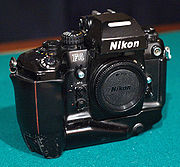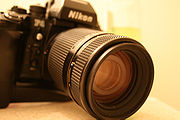
Nikon F4
Encyclopedia

Nikon
, also known as just Nikon, is a multinational corporation headquartered in Tokyo, Japan, specializing in optics and imaging. Its products include cameras, binoculars, microscopes, measurement instruments, and the steppers used in the photolithography steps of semiconductor fabrication, of which...
's line of F series
Nikon F
The Nikon F camera, introduced in 1959, was Nikon's first SLR camera. It was one of the most advanced cameras of its day. Although most of its concepts had already been introduced elsewhere, it was the first camera to combine them all in one camera. It was produced until October 1973 and was...
professional cameras. With industrial design by Giorgetto Giugiaro
Giorgetto Giugiaro
Giorgetto Giugiaro is an Italian automobile designer responsible equally for a stable of supercars and several of the most popular everyday vehicles driven today...
, the F4 was the first professional Nikon to offer autofocus and is able to accept any of Nikon's manual focus (MF) or AF lenses from 1959 to the present day, including the two F3AF lenses (in Autofocus mode). The F4 replaced the F3
Nikon F3
The Nikon F3 was Nikon's third professional single-lens reflex camera body, preceded by the F and F2. Introduced in 1980, it had manual and semi-automatic exposure control whereby the camera would select the correct shutter speed . The Nikon F3 series cameras had the most model variations of any...
, which was a manual focus camera produced from 1980 until around the year 2000. Nikon introduced its next flagship model, the F5
Nikon F5
The Nikon F5 is a 35 mm film-based single-lens reflex camera body manufactured by Nikon from 1996 through 2004. It was the fifth in Nikon's professional film camera line, which began in 1959 with the Nikon F. It followed the Nikon F4 of 1988, which had introduced in-body autofocus to Nikon's...
, in 1996. All F4 models were discontinued soon after, in May 1997.
Features
The F4 introduced many Nikon owners to autofocus (as well as focus tracking), and was the first professional Nikon to utilize a vertical-travel metal-blade shutter (with shutter balancer to minimize noise and camera bounce). As a fully electronic camera with motorized film transport (up to 5.7 frames per second), it required one of three available bottom-mounted battery packs to operate, using standard AA or rechargeable cells. For the first time on a Nikon SLR, two of those battery packs also offered an additional vertical shutter release button and grip for using the camera vertically.Its controls were transitional between those of mechanical SLRs and future professional film and digital SLRs: the F4's electronics, LCD viewfinder display, autofocus, programmed auto-exposure, and matrix meter looked to the future, but it also retained classic dedicated analog dials for shutter speed, lens aperture, metering pattern, and exposure compensation.
The F4 was the first Nikon F-series camera to lack a manual film-advance lever, though it offered both motor-driven and manual film rewinding. Like previous F-series cameras, the F4 featured a high degree of customization to specific tasks, with various remote controls, film backs, and viewfinders available. While it was a complex camera with over 1700 parts, the F4's high-quality mechanical and electronic components, as well as weather sealing and tough construction, made for a reliable and long-lived professional SLR.
Lens compatibility

Its lack of electronic aperture control limits the F4's functionality with G type lenses, which do not have an aperture ring. With these lenses, exposure control is limited to program and shutter-priority modes. In addition, DX lenses are not designed to cover the full 35mm frame and will vignette when used with the F4 (or any other 35mm camera). The F4 also provides no support for Nikon's later VR (Vibration Reduction) system; VR-equipped lenses will mount and function, but without image stabilization.
Model line
Eventually Nikon had three F4 models that were distinguished by which integrated battery pack was attached. All F4 bodies are interchangeable with all battery packs. Therefore none of the cameras includes a label for its particular model name—all use a simple "F4" nameplate:| model | battery pack | introduced | advance speed | batteries | features |
|---|---|---|---|---|---|
| F4 | MB-20 | 1988 | 4.0 frame/s | 4 AA | most compact |
| F4S | MB-21 | 1988 | 5.7 frame/s | 6 AA | vertical shutter release |
| F4E | MB-23 | 1991 | 5.7 frame/s | 6 AA or Ni-Cd (MN-20) | largest pack, vertical shutter release, 250 exposure Bulk Film Multi-Control Back MF-24 terminal |

